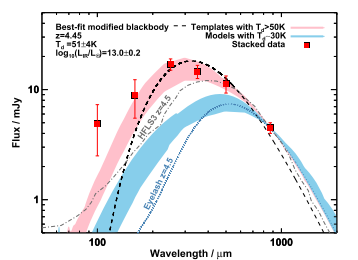Extremely distant galaxies are hard to find, and even more difficult to confirm. With observations from the Atacama Large Millimeter/submillimeter Array (ALMA) in Chile, Dr. Elizabeth Cooke (a postdoctoral researcher at Durham University) and her collaborators, including a joint PhD student from PMO (Fangxia An) have now detected ten new galaxies at redshift z=4.4-4.6 (12.3 billion light years away). These galaxies are forming stars at phenomenal rates – thousands of solar masses per year – and their star formation regions are surrounded by a large amount of dust. The high rate of star formation has heated up this dust to more than 50K – nearly twice as warm as similar galaxies that are closer to Earth. This sample of ten galaxies places constraints on how many more galaxies of their kind may exist. We now think that about 7% of the highly star-forming, dusty galaxy population lie between z=4 and z=5 (12.1-12.5 billion light years away) – meaning there are a lot more out there to discover. 
By with AN Fangxia Fig.Composite infrared SED from Herschel PACS/SPIRE and ALMA for our 10 line emitters with uncertainties determined from a bootstrap analysis. The dashed black line shows the best modified blackbody fit to this photometry with β = 1.8. The best-fit parameters are shown in the top left. Overlaid are shaded regions showing the region occupied by template SEDs with temperatures Td > 50 K and 28 K < Td < 35 K. The SED of our AS2UDS SMGs at z ; 4.5 suggests warm dust temperatures for these high-redshift galaxies. Also plotted are the SEDs of two well-studied SMGs, SMMJ2135 ?0102 (the Eyelash; Swinbank et al. 2010b), and HFLS3 (Riechers et al. 2013; Cooray et al. 2014), redshifted to z = 4.5 and normalized to the average flux density of our sample at 870 μm. Link to the original research paper: http://adsabs.harvard.edu/abs/2018ApJ...861..100C (ApJ.861:100 2018) |
